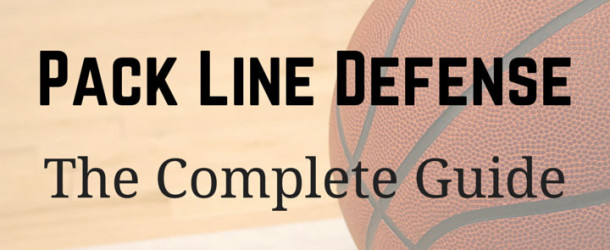The ‘Pack Line’ was created by Dick Bennett of Wisconsin-Stevens Point, Wisconsin-Green Bay, University of Wisconsin, and Washington State. It is now commonly used in some form by many coaches including Tom Izzo at Michigan State, Sean Miller and Chris Mack at Xavier, Tony Bennett at Virginia, and Steve Alford at UCLA.
For a bit of history, the term ‘Pack Line’ wasn’t coined or even thought of by Bennett. The word was brought to the attention of Bennett by a person at a marketing company after convincing Bennett to create a DVD on his new defensive system.
Overview of Pack Line Defense
The ‘Pack Line’ defense is a variation of man-to-man defense. The biggest difference between the two is that instead of the off-ball defenders being out pressuring their player and denying the pass, everyone except the player guarding the ball must be inside an imaginary line 16 feet from the rim.
This 16ft line is know as the pack line. You can see the differences in positioning in the diagrams below…

At all times there must be one defender pressuring the player with the basketball, and four defenders in gap/help positions. The only exception is if the offensive player picks up the dribble and it becomes a ‘dead ball’, then all players can go out and deny looking for the steal.
The premise behind this defense is that by having four players within the pack line, it discourages the opposition from penetrating and getting inside the paint and forces them to beat you with well executed offense and great outside shooting.
When the ball is passed around the perimeter, the next defender closes out with high hands to prevent the rhythm shot and then provides on-ball pressure while the defender who was playing on-ball defense falls back within the packline.
Again just to emphasize the most important point… At all time there must be one defender pressuring the player with the basketball and four defenders in gap/help positions.
What teams give up in exchange for always being in help position is that players don’t have the benefit of denying the pass on the perimeter. This is why the pack line defense is also referred to as ‘sagging man-to-man’.
For this reason, the pack line defense requires the players to be patient and play smart defense until the offensive team takes a contested jump shot, or makes a mistake.
As you can probably tell, all five players must work together as a defensive unit for this defense to be successful. If any of the five players aren’t performing their job properly, there will be open gaps that can lead to easy scores.
Advantages of Pack Line Defense
1. Prevents Dribble Penetration – Due to four defenders always being inside the pack line, the offensive players will be find it hard to find gaps through the wall of defenders.
2. Prevents Back-Door Cuts – This is a great defense if you’re playing against an offense like the Princeton offense that likes to utilize the back-door cut. Since your players are sagging off their man, the offensive team will find it hard to get easy layups off back-door cuts.
3. Lower Opponent Field Goal Percentage – If your team can be patient on defense and not gamble, it will lead to the opponent taking tough contested jump shots.
4. Increased Rebounding – Sagging off their players will put your players in better rebounding positions… as long as they box out.
5. No Easy Scores – This advantage ties in with dribble penetration. If the opponent can’t get to the ring and your defense is packing the paint, there will be no easy opportunities to score.
6. Always in Help Position – Unlike traditional man-to-man defense, your players don’t need to move to be in help position… they’re already there!
Weaknesses of Pack Line Defense
1. Three Pointers Can Beat You – As your players are playing off their player and are in help position, it can lead to open three-pointers if your players don’t react quick enough and close out on the ball. If a team gets hot from three
2. If There’s No Shot Clock – If you coach in a league that doesn’t use a shot clock then the opposition can use as much time as they like passing the ball around the perimeter until they find an open shot. It will come down to who is more patient, the offense or defense.
3. Must Be Patient – One problem that arises when using this defense at a youth level is the players sometimes aren’t patient enough. They want to gamble and get a steal so they can stop playing defense and start playing offense.
The 7 Areas of Pack Line Defense
1. Transition/Conversion Defense
Transition defense is the start of every defensive possession and could be the most important of all. There are two main things you need to remember…
1. Never allow easy buckets in transition.
2. “Always take a guy out if he loafs back during a game” – Dick Bennett
The first thing coaches must do is decide how many players they want to send to glass for offensive rebounds and how many they want to immediately send back.
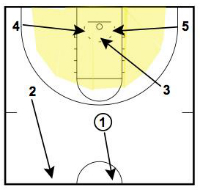
We recommend to always send two guards back on defense and the other three to the glass. That means the guards must get back as soon as the shot is put up… not after the rebound is secured by the other team.
When the ball is rebounded by the other team or a shot is made, the three players that went to the glass must turn and SPRINT back to half-way without regard for their player. Sprinting to half-way in non-negotiable and players should immediately be subbed out if they don’t do it. When they get to half court, then they can find their player and establish proper defensive position.
No easy transition scores!
2. On Ball Defense
Contrary to what some coaches think about the pack line defense, there should be A LOT of pressure placed on the ball-handler.
Whoever is on the player with the basketball should be right up on them and harassing them without fouling. We want to make it difficult for them to see the floor and it will make it difficult for the other team to pick as apart with their passing.
The reason we can allow the on-ball defender to apply so much pressure to their player is because, as long as everyone’s in the right position and are playing as a unit, they have the confidence that if they get beat off the dribble then there will be immediate help.
Even if they offensive player thinks they can beat their defender one-on-one, they’re going to look up and see a wall of defenders and pass the ball off to the next guy.
To teach our players to apply constant pressure we run a lot of one-on-one drills with lots of pressure and recommend you do too. You need to get your players comfortable with being so close to the offensive player.
3. Off Ball Defense
While the on-ball defender is applying constant pressure to the ball, the other four players should be within the pack line in their correct gap/help position.
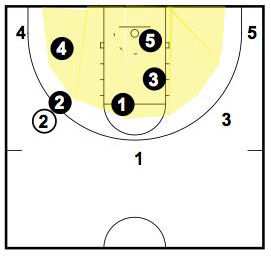
At all times players should be in a ball-you-man position and down in a low stance ready to react if a pass is made.
If your players are ever out of stance you should immediately sub them out of the game. If they’re not in the correct position that’s not always bad depending on how new the defense is to them. They might just need more practice at learning where they’re meant to be. But being in stance is an attitude towards defense and should be non-negotiable.
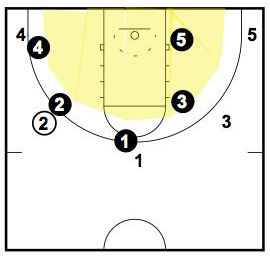
Players must constantly be readjusting their position to the correct gap as the ball is passed around on offense. Remember: All five players MUST be working together as a unit for this defense to be successful.
The only exception to the rule of being within the pack line is if the ball is picked up by the offensive player and become a ‘dead ball’. In that case, everyone hustles out to their player and denies the pass looking for the steal. If a pass is made by the offensive team everyone hustles back to their correct gap position.
4. Close Outs
Since all off ball defenders are always in help positions, they must recover to their player every time they catch the ball. This means they’ll be closing out very, very regularly and must to learn how to do it properly.
There are a few important things for players to remember and coaches to teach when closing out…
1. High Hands – We need to keep our hands up on the close out to discourage the rhythm shot.
2. Short Choppy Steps – The last couple of steps should be short and choppy. This allows you to keep your weight back and absorb the dribble.
3. No Baseline – Don’t allow your player to get an easy baseline drive on the close out. Close out so that if they do happen to get by you, they’re running into the help defence in the middle of the floor.
5. Don’t Give Up Baseline
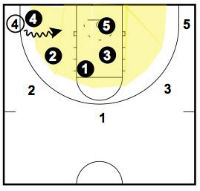
This is more a ‘rule’ of the defense than it is an area… but because of how important it is to the success of the defense, I thought I’d include it anyway.
Under no circumstances do we let the opposition drive the ball baseline. If they drive baseline we get beat.
We need to force the dribbler towards the middle of the floor where our help defenders are located.
You’ll understand the importance of not giving up baseline in the next section when we discuss post-play.
6. Guarding the Post
How you defend the post is one of the few aspects of the pack line defense that the coach will control and that will change on a game-to-game basis.
Guarding the post can be broken down into two areas…
1. Before the post gets the ball

When we’re in pack line defense we never want the ball to get into the post. That’s the danger zone. How we prevent the ball from entering the post changes with different coaches.
Coach Bennett teaches to 3/4 front the post from the high side and discourage the pass. The reason he never fronts the post is because he doesn’t want to allow offensive rebounds and easy baskets.
Coach Boone allows his team to front when the ball is below the free-throw line to completely discourage the ball entering the post at all.
2. When the ball is in the post
It’s crucial that on the flight time of the ball entering the post, your players slip behind their player and establish good defensive position on the post player.
One of the main early rules of the pack line defense was “if the ball gets into the post area, get it out of there as soon as possible”. I believe this isn’t as important as it used to be since we’ve entered the era of perimeter bigs and post-play skill has gone down. Also, if you’re running this defense with a youth team, doubling the post isn’t usually necessary.
So the first thing you need to do is decide whether you’re going to double the post or not. Traditional pack line defense doubles anyone in the post. The great thing about this strategy is that the players don’t have to decide whether to quickly go and double or not. They KNOW they have to straight away. So there is no confusion.
If you choose to double only the one or two best post players on the other team, it will slow down the double because it forces the players to think.
I won’t go into extensive detail on the different methods of doubling the post because I’ve written a thorough article about that topic here, but you need to decide what’s best for your team.
Dick Bennett recommended two methods:
1. Choke the Post – This involves bringing the closest perimeter player down looking for a deflection if the post puts the ball on the ground and to force the big to pass the ball back out.
2. Big to Big – Bennett like doubling big-to-big because they’re close and usually are the taller and longer defenders on the court. The guards are also quicker to rotate.
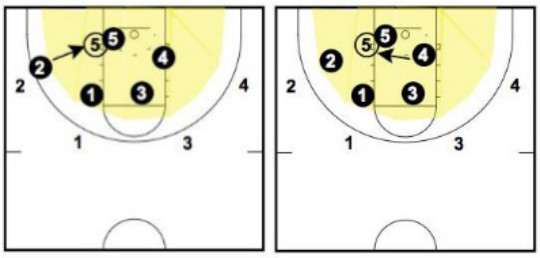
One last very important note: Never allow the basketball to be fed to the post player from the top of the key.
7. Defending Screens
Coach Bennett believes in fighting through all screens and not cheating. He doesn’t like switching because he feels it will hurt the team come the end of the season.
Players should be within touching distance of their player at all times when they’re being screened. He believes that if you’re that close and have are determined to get through the screen, then the screen won’t be very effective.
One important thing to note is that while being screened the only responsibility the player has is to chase down the player running off the screen. They shouldn’t worry about helping at all. Just chasing down their player.
The only exception to the ‘fight through all screens’ rule is when the screen is set on the weak side of the floor and the obvious option is to cheat over or under the screen and still be in position.
8. Rebounding

Everyone knows the saying… “A defensive possession doesn’t end until we’ve secured the defensive rebound”. That means we can’t slack off after forcing them into a contested shot… we have to go and get the ball!
On the shot everyone needs to find their player and box out. If they’re in the right help position we will usually have a good advantage to establish early positioning first.
The key is for players to be aggressive and really want to rebound the basketball.
Conclusion
The Pack Line defense really is a ‘team’ defense. Everyone must to be on the same page defensively for it to be effective. If there’s anyone on the team not in position it can lead to easy defensive breakdowns.
It’s a great defense to implement for teams on any level. It’s can be used in youth basketball teams all the way up to variations of the pack line defense in the NBA. It cuts down penetration, forces the other team to beat you from outside, emphasizes the importance of playing as a unit, and teaches them how to play in help position.

